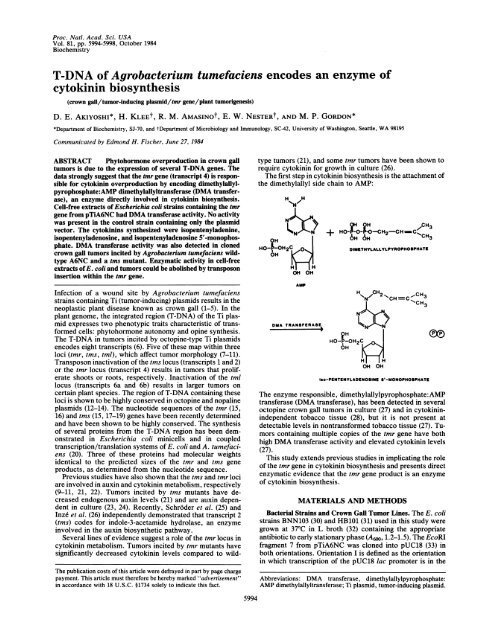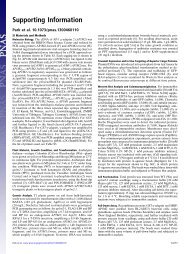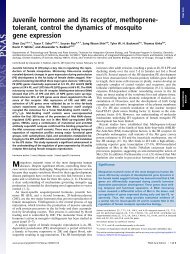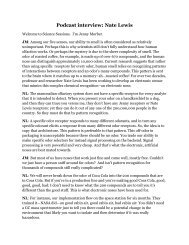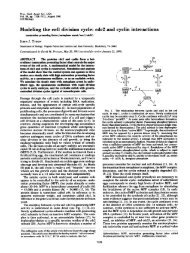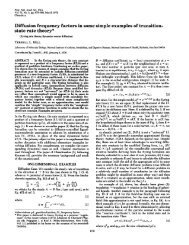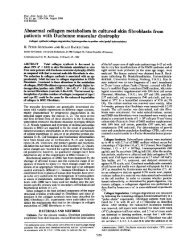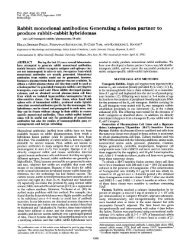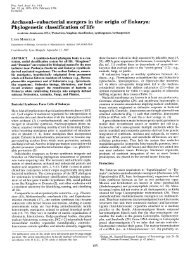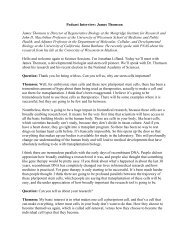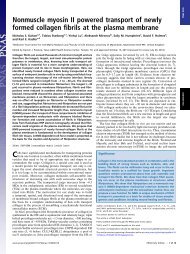cytokinin biosynthesis
cytokinin biosynthesis
cytokinin biosynthesis
Create successful ePaper yourself
Turn your PDF publications into a flip-book with our unique Google optimized e-Paper software.
Proc. Nati. Acad. Sci. USA<br />
Vol. 81, pp. 5994-5998, October 1984<br />
Biochemistry<br />
T-DNA of Agrobacterium tumefaciens encodes an enzyme of<br />
<strong>cytokinin</strong> <strong>biosynthesis</strong><br />
(crown gall/tumor-inducing plasmid/tmr gene/plant tumorigenesis)<br />
D. E. AKIYOSHI*, H. KLEEt, R. M. AMASINOt, E. W. NESTERt, AND M. P. GORDON*<br />
*Department of Biochemistry, SJ-70, and tDepartment of Microbiology and Immunology, SC-42, University of Washington, Seattle, WA 98195<br />
Communicated by Edmond H. Fischer, June 27, 1984<br />
ABSTRACT Phytohormone overproduction in crown gall<br />
tumors is due to the expression of several T-DNA genes. The<br />
data strongly suggest that the Imr gene (transcript 4) is responsible<br />
for <strong>cytokinin</strong> overproduction by encoding dimethylallylpyrophosphate:AMP<br />
dimethylallyltransferase (DMA transferase),<br />
an enzyme directly involved in <strong>cytokinin</strong> <strong>biosynthesis</strong>.<br />
Cell-free extracts of Escherichia coli strains containing the tmr<br />
gene from pTiA6NC had DMA transferase activity. No activity<br />
was present in the control strain containing only the plasmid<br />
vector. The <strong>cytokinin</strong>s synthesized were isopentenyladenine,<br />
isopentenyladenosine, and isopentenyladenosine 5'-monophosphate.<br />
DMA transferase activity was also detected in cloned<br />
crown gall tumors incited by Agrobacterium tumefaciens wildtype<br />
A6NC and a tms mutant. Enzymatic activity in cell-free<br />
extracts of E. coli and tumors could be abolished by transposon<br />
insertion within the tmr gene.<br />
Infection of a wound site by Agrobacterium tumefaciens<br />
strains containing Ti (tumor-inducing) plasmids results in the<br />
neoplastic plant disease known as crown gall (1-5). In the<br />
plant genome, the integrated region (T-DNA) of the Ti plasmid<br />
expresses two phenotypic traits characteristic of transformed<br />
cells: phytohormone autonomy and opine synthesis.<br />
The T-DNA in tumors incited by octopine-type Ti plasmids<br />
encodes eight transcripts (6). Five of these map within three<br />
loci (tmr, tms, tml), which affect tumor morphology (7-11).<br />
Transposon inactivation of the tms locus (transcripts 1 and 2)<br />
or the tmr locus (transcript 4) results in tumors that proliferate<br />
shoots or roots, respectively. Inactivation of the tml<br />
locus (transcripts 6a and 6b) results in larger tumors on<br />
certain plant species. The region of T-DNA containing these<br />
loci is shown to be highly conserved in octopine and nopaline<br />
plasmids (12-14). The nucleotide sequences of the tmr (15,<br />
16) and tms (15, 17-19) genes have been recently determined<br />
and have been shown to be highly conserved. The synthesis<br />
of several proteins from the T-DNA region has been demonstrated<br />
in Escherichia coli minicells and in coupled<br />
transcription/translation systems of E. coli and A. tumefaciens<br />
(20). Three of these proteins had molecular weights<br />
identical to the predicted sizes of the tmr and tms gene<br />
products, as determined from the nucleotide sequence.<br />
Previous studies have also shown that the tms and tmr loci<br />
are involved in auxin and <strong>cytokinin</strong> metabolism, respectively<br />
(9-11, 21, 22). Tumors incited by tms mutants have decreased<br />
endogenous auxin levels (21) and are auxin dependent<br />
in culture (23, 24). Recently, Schroder et al. (25) and<br />
Inze et al. (26) independently demonstrated that transcript 2<br />
(tms) codes for indole-3-acetamide hydrolase, an enzyme<br />
involved in the auxin biosynthetic pathway.<br />
Several lines of evidence suggest a role of the tmr locus in<br />
<strong>cytokinin</strong> metabolism. Tumors incited by tmr mutants have<br />
significantly decreased <strong>cytokinin</strong> levels compared to wild-<br />
The publication costs of this article were defrayed in part by page charge<br />
payment. This article must therefore be hereby marked "advertisement"<br />
in accordance with 18 U.S.C. §1734 solely to indicate this fact.<br />
5994<br />
type tumors (21), and some tmr tumors have been shown to<br />
require <strong>cytokinin</strong> for growth in culture (26).<br />
The first step in <strong>cytokinin</strong> <strong>biosynthesis</strong> is the attachment of<br />
the dimethylallyl side chain to AMP:<br />
N<br />
Ni<br />
OH<br />
HO4+OH2 ',o..<br />
OH Kw)I<br />
OH OH<br />
AMP<br />
DMA TRANSFERASE<br />
?2H 5t H3<br />
+ HO-
Biochemistry: Akiyoshi et al.<br />
393 349 149 169<br />
tma tmr (ml Ocs<br />
5(1.20) 2(1.75) 4(1.25) 3(1.45)<br />
7(0.73) 1(2.7) 6ab(0.92)<br />
BamHI 19H II8 11291<br />
2<br />
EcoRi 2 A 7 111 24 |<br />
pDQ64<br />
PD0 14<br />
pNW34D-7 -I _<br />
FIG. 1. Locations of T-DNA loci and transcripts in the T-DNA<br />
of pTiA6NC. The four identified genetic loci (tmr, tms, tml, ocs)<br />
and the locations of the eight transcripts are shown (6, 9, 11, 34).<br />
The polarity of each transcript is indicated by the direction of the<br />
arrow and the transcript size (in kilobases) is shown. Transposon<br />
(TnS) insertions used in this study are indicated at the top of the<br />
figure. Solid bars below the map represent the plasmid clones containing<br />
T-DNA fragments.<br />
same direction as 5' -+ 3' polarity of the tmr gene, and<br />
orientation II is defined as the opposite orientation. Digestion<br />
of pUC18-EcoRI 7 (orientation I) with Kpn I followed<br />
by religation produced a 4.2-kilobase EcoRI/Kpn I subclone<br />
containing only transcripts 1 and 4 (pDQ14; Fig. 1). A 6.1kilobase<br />
EcoRI/Sal I subclone (pDQ64; Fig. 1), containing<br />
transcripts 4, 6a, and 6b, was generated by Sal I digestion<br />
and religation to pUC18-EcoRI 7 (orientation II).<br />
The plasmid pRA120 was constructed in the following<br />
manner: The 5' end of the tmr gene was isolated as an Ava<br />
II/BamHI fragment, which extends from the second codon<br />
of the tmr gene to the BamHI 29/19 junction. The Ava II<br />
overhang was filled in to produce a blunt end and the fragment<br />
was ligated into pUC18 cut with Sma I/BamHI. This<br />
generated an in-frame translational fusion between the a<br />
peptide of 83-galactosidase and the 5' end of the tmr gene. The<br />
tmr gene was then reconstituted by cutting this plasmid with<br />
BamHI/Sal I, and a restriction fragment consisting ofBamHI<br />
19 to the Sal I site of a TnS insertion in transcript 6a was<br />
inserted. Thus, pRA120 contains the entire tmr gene linked<br />
to the first 10 codons of the a peptide of f8-galactosidase. The<br />
resulting protein is expected to have 10 additional amino<br />
acids (Thr-Met-Ile-Thr-Asn-Ser-Ser-Ser-Val-Pro) at the<br />
amino terminus of the tmr gene.<br />
Construction of pRR290-EcoRI (pNW34D-7-1) and<br />
pRK290-EcoRI 7::TnS (pNW34D-7-1::TnS) plasmids have<br />
been described (34). Tn5 insertions 149 and 169 map within<br />
the tmr locus, and insertion 393 maps within the tms locus.<br />
Insertion 349 is a wild-type TnS insertion (Fig. 1) (11).<br />
The cloned crown gall tumor lines (Nicotiana tabacum cv.<br />
Xanthi nc or White Burley) were incited by A. tumefaciens<br />
strains containing either pTiA6NC or pTiA6NC::Tn5 (34).<br />
The tumor lines were grown under continuous light on solid<br />
Murashige-Skoog medium (35) without phytohormones.<br />
Preparation of Cell-Free Extracts. Bacterial cells (2 g, wet<br />
weight) were harvested by centrifugation (4100 x g, 5 min,<br />
40C), resuspended in 3-5 ml of buffer A [40 mM Hepes, pH<br />
7.3/10 mM MgCl2/20 mM KCl/1 mM EDTA/0.5 mM<br />
dithiothreitol/0.1 mM phenylmethylsulfonyl fluoride/20%<br />
(vol/vol) glycerol] and sonicated 6 times (30 sec each) (Sonifier<br />
Cell Disruptor, Heat System/Ultrasonics, Plainview,<br />
NY). The cell lysate was diluted to 20 ml with buffer A,<br />
centrifuged (12,000 x g, 30 min, 40C) to remove cell debris,<br />
and solid ammonium sulfate (5.6 g/ml; 85% saturation) was<br />
added over a 20-min period. After 90 min, the precipitate was<br />
collected by centrifugation (12,000 x g, 60 minm 4C), dissolved<br />
in 7 ml of buffer A, and dialyzed against buffer A<br />
(1000 ml, 2 changes, 14 hr, 40C). The dialysate was clarified<br />
by centrifugation (12,000 x g, 20 min, 40C), diluted with 100<br />
IX6<br />
Proc. Natl. Acad. Sci. USA 81 (1984) 5995<br />
ml of buffer A containing 50 mM Hepes (1:1, vol/vol) and<br />
applied to a small DEAE-cellulose column. The protein<br />
fraction containing DMA transferase activity was eluted with<br />
buffer A containing 0.3 M KCl and stored at - 70'C for<br />
assay.<br />
Cell-free extracts of tumor tissue (3 weeks old; 10 g, fresh<br />
weight) were prepared as described (27) except XAD-4 was<br />
omitted and the samples were dialyzed as described above<br />
for the bacterial samples.<br />
DMA Transferase Assay. Enzyme preparations from either<br />
bacterial cells (equivalent to 0.5 g, wet weight, of cells) or<br />
tumor tissue (equivalent to 2 g, fresh weight, of tissue) were<br />
assayed in duplicate. The assay reaction (8 ml) contained<br />
0.12 M Hepes, pH 7.3/0.16 M KCI/15 mM MgCl2/7 mM<br />
KF/0.5 mM EDTA/0.25 mM dithiothreitol/0.05 mM phenylmethylsulfonyl<br />
fluoride/10% (vol/vol) glycerol. The reaction<br />
was started by the addition of 0.43 mM dimethylallylpyrophosphate<br />
synthesized by the method of Cornforth<br />
and Popjak (36) and [2-3H]AMP (74-148 kBq; 443<br />
GBq/mmol; Amersham). After a 90-min incubation at 220C,<br />
<strong>cytokinin</strong>s were adsorbed onto a small octadecylsilica column,<br />
eluted with methanol, and dried in vacuo.<br />
Some samples were treated with alkaline phosphatase<br />
prior to HPLC as follows: alkaline phosphatase (bovine<br />
intestinal; 12 units; Sigma) in 1 ml of 50 mM Tris HCl (pH<br />
9.2) and 20 mM MgCl2 was added to the dried samples and<br />
incubated 15-18 hr at 370C. Cytokinins were adsorbed onto<br />
a small octadecylsilica column, eluted with methanol, and<br />
dried.<br />
HPLC. Samples were subjected to HPLC as described<br />
(27), with minor modifications. To resolve the radiolabeled<br />
products of the cell-free extracts, samples were fractionated<br />
on an octadecylsilica column (25 cm x 4.6 mm; Ultrasphere<br />
ODS 5 um; Altex, Berkeley, CA) using the following gradient<br />
program (flow rate, 1 ml/min): 12%-18% CH3CN over<br />
10 min (curve 3, Waters Automated Gradient Programmer),<br />
18%-23% over 12 min (curve 3), held at 23% for 6 min,<br />
23%-30o over 2 min (curve 6), and then held at 30% for 2<br />
min. The samples were applied in 100 ttl of CH3CN/0.1 M<br />
triethylammonium acetate (60:40, vol/vol), fractions were<br />
collected (0.5 min), and radioactivity was determined.<br />
To estimate DMA transferase activity in bacterial and<br />
tumor extracts, samples were dissolved in 80 ,ul of methanol<br />
and chromatographed under isocratic conditions (0.1 M triethylammonium<br />
acetate, pH 3.4/CH3CN) (79:21, vol/vol).<br />
RESULTS<br />
Identification of Cytokinins. Addition of dimethylallylpyrophosphate<br />
and [3H]AMP to cell-free extracts of E.<br />
coli containing either the plasmid vector or the tmr gene<br />
resulted in the incorporation of radioactivity into <strong>cytokinin</strong>s,<br />
which were subsequently identified by HPLC. The strain<br />
containing only the pUC18 plasmid had a single peak of<br />
radioactivity at a retention time (3.5-4.5 min) corresponding<br />
to the mobility of polar compounds including AMP, adenine,<br />
and adenosine (Fig. 2 A and B). However, strains containing<br />
the tmr gene had three additional radioactive species, which<br />
were not found in the control strain without the tmr gene.<br />
The retention times of these species corresponded to mobilities<br />
of authentic standards of isopentenyladenosine 5'monophosphate<br />
(15-16 min), isopentenyladenine (25.5-27<br />
min), and isopentenyladenosine (27.5-28 min). A typical<br />
radioactivity profile for strains containing the tmr gene is<br />
shown in Fig. 2D.<br />
Over 50% of the radioactivity incorporated into <strong>cytokinin</strong>s<br />
was present as isopentenyladenine. If the samples were<br />
treated with alkaline phosphatase prior to HPLC, radioactivity<br />
in the isopentenyladenosine 5'-monophosphate fraction<br />
disappeared, but radioactivity in the isopentenyladenosine
5996 Biochemistry: Akiyoshi et al.<br />
0<br />
x<br />
E<br />
0<br />
0<br />
15 20<br />
Time, min<br />
FIG. 2. Radioactivity profile of E. coli cell-free extracts on<br />
HPLC. Cytokinins were adsorbed onto octadecylsilica, eluted, and<br />
fractionated on HPLC. One set of extracts (A and C) were treated<br />
with alkaline phosphatase prior to HPLC. (A and B) E. coli control<br />
strain containing plasmid vector; (C and D) E. coli strains containing<br />
tmr gene. Retention times of <strong>cytokinin</strong> standards are indicated<br />
by horizontal bars (-) in D: Ade, adenine; Ado, adenosine; AMP,<br />
adenosine 5'-monophosphate; t-Z, trans-zeatin; t-ZR, transribosylzeatin;<br />
c-ZR, cis-ribosylzeatin; iPA-P, isopentenyladenosine<br />
5'-monophosphate; iP, isopentenyladenine; iPA, isopentenyladenosine.<br />
region increased (Fig. 2C). The radioactivity in the isopentenyladenine<br />
and isopentenyladenosine fractions can be precipitated<br />
by isopentenyladenosine-specific antibodies (data<br />
not shown). No radioactivity was detected in fractions corresponding<br />
to the retention times of trans-zeatin, transribosylzeatin,<br />
cis-zeatin, or cis-ribosylzeatin (Fig. 2 C and D).<br />
Proc. Natl. Acad. Sci. USA 81 (1984)<br />
Table 1. DMA transferase activity in E. coli strains and crown<br />
gall tumors<br />
Radioactivity in<br />
iP/iPA region,*<br />
cpm<br />
NDt<br />
10,100<br />
Plasmid<br />
pUC18<br />
pRA120<br />
pUC18-EcoRI 7<br />
(orientation I)<br />
pDQ14<br />
pUC18-EcoRI 7<br />
(orientation II)<br />
pDQ64<br />
pRK290<br />
pRK290-tmr-149::TnS<br />
pRK290-tmr-169::TnS<br />
pRK290-EcoRI::TnS<br />
(349)<br />
Crown gall tumor lines<br />
A6S/2t<br />
tmr-149<br />
tmr-169<br />
tms-393<br />
7,730<br />
14,900<br />
4,190<br />
2,750<br />
20<br />
80<br />
2,400<br />
10,820<br />
8,950<br />
ND<br />
450<br />
31,830<br />
The assay mixture contained cell-free extract from E. coli (0.5 g,<br />
fresh weight) or crown gall tumor tissue (2 g, fresh weight), 0.43 mM<br />
dimethylallylpyrophosphate and 74-148 kBq [3H]AMP. Incubation<br />
was for 90 min at 220C.<br />
*13 cpm = 1 fmol isopentenyladenine (iP)/isopentenyladenosine<br />
(iPA) synthesized.<br />
tND, not detected.<br />
tN. tabacum cv. White Burley. Other tumor lines were incited on<br />
N. tabacum cv. Xanthi nc.<br />
DMA Transferase Activity in Bacterial Ceil-Free Extracts.<br />
Having established the identity of the <strong>cytokinin</strong>s made by<br />
cell-free extracts of E. coli, DMA transferase activity was<br />
estimated in several strains containing the tmr gene. Samples<br />
were treated with alkaline phosphatase prior to HPLC and<br />
were chromatographed under conditions whereby isopentenyladenine<br />
and isopentenyladenosine had identical retention<br />
times (11-12 min). The EcoRI fragment 7 from pTiA6NC,<br />
an octopine-type plasmid, was cloned into pUC18 in both<br />
orientations. DMA transferase activity was detected in both<br />
strains containing this fragment, although activity was higher<br />
in orientation I (Table 1). The EcoRI fragment 7 contains, in<br />
addition to tmr, transcripts 1 (tms) and 6a and 6b (tml). Two<br />
additional constructs were made, which removed either the<br />
tms or tml transcripts. This eliminated the possibility that<br />
one of these transcripts was responsible for DMA transferase<br />
activity. Strains containing the EcoRI/Kpn I subclone<br />
(pDQ14), which contains tmr and transcript 1 but not transcripts<br />
6a and 6b, retained DMA transferase activity. Enzymatic<br />
activity was also retained in strains containing the<br />
EcoRI/Sal I subclone (pDQ64), which contains tmr and<br />
transcript 1.<br />
To demonstrate unambiguously that DMA transferase activity<br />
was correlated with the tmr gene, a translational fusion<br />
was constructed (pRA120) fusing the tmr structural gene to<br />
the ,B-galactosidase a peptide encoded by pUC18. This fusion<br />
deletes the initiation codon from the amino terminus of<br />
the tmr protein and replaces it with the first 10 codons of pgalactosidase.<br />
Cell-free extracts of E. coli containing pRA120<br />
had DMA transferase activity equivalent to the strain containing<br />
pUC18-EcoRI 7 (orientation I, Table 1).<br />
The availability of E. coli strains containing Tn5 insertions<br />
in the tmr gene made it possible to extend the correlation<br />
between DMA transferase activity and the tmr gene. HB101<br />
containing only pRK290 had no detectable DMA transferase<br />
activity (Table 1). However, HB101 containing the EcoRI 7<br />
fragment with a TnS insertion in a region that had no detect-
Biochemistry: Akiyoshi et al.<br />
able effect on tumor morphology (Fig. 1), had activity comparable<br />
to that observed for BNN103 strains containing the<br />
tmr gene. Two tmr mutations, 149 and 169, encoded no<br />
activity and 22% activity, respectively. Additional mapping<br />
studies of insertion 169 have determined its location to be 25<br />
+ 5 bases downstream from the 3' end of the open reading<br />
frame.<br />
DMA Transferase Activity in Crown Gall Tumor Extracts.<br />
Finally, DMA transferase activity in cell-free extracts of<br />
cloned tumor lines incited by tmr mutants was compared to<br />
activity in wild-type tumors. Consistent with the level of<br />
activity measured in the bacterial extracts, tumors incited by<br />
tmr-149::TnS had no detectable DMA transferase activity,<br />
while tumors incited by tmr-169::TnS had o5% of the activity<br />
measured in wild-type tumors (Table 1). A tms-transcript<br />
2 mutant Qms-393::TnS) had a 3-fold higher DMA<br />
transferase activity than wild-type tumors.<br />
DISCUSSION<br />
Transposon mutagenesis defines three genetic loci (tmr, tms,<br />
tml) in the octopine T-DNA that affect tumor morphology<br />
(7-11). On tobacco stems, tms mutants and mr mutants<br />
incite tumors characterized by shoot or root proliferation,<br />
respectively. Tumors incited by tml mutants are unorganized,<br />
like parental wild-type tumors, but larger than wildtype<br />
tumors are observed on Kalanchoe leaves. The morphology<br />
of these tumors results from a change in the hormonal<br />
balance due to expression of the T-DNA and follows<br />
the pattern originally described by Skoog and Miller for<br />
normal tobacco tissue (37). Specifically, tmr tumors have<br />
low <strong>cytokinin</strong>/auxin ratios, which favor root formation, and<br />
tms mutants have high <strong>cytokinin</strong>/auxin ratios, which promote<br />
shoot production (21). Tumors incited by tml mutants<br />
have ratios similar to the wild-type unorganized tumors.<br />
In this paper, we have presented strong evidence suggesting<br />
that the tmr gene encodes the <strong>cytokinin</strong> biosynthetic<br />
enzyme, DMA transferase, which attaches the dimethylallyl<br />
side chain to AMP to form isopentenyladenosine 5'monophosphate.<br />
Acquisition of DMA transferase activity in<br />
E. coli was strictly correlated with the presence of the tmr<br />
gene, which was expressed either from its own promoter or<br />
from the pUC18 lac promoter. In one strain, enzymatic<br />
activity was abolished by TnS insertion into the tmr gene. In<br />
another tmr strain containing a TnS insertion between the 3'<br />
end of the open reading frame and the polyadenylylation<br />
signal, DMA transferase activity was decreased by almost<br />
80%. No activity was detected in the strain containing only<br />
pRK290. We could not detect DMA transferase activity in A.<br />
tumefaciens containing pTiA6NC or pTiA6NC: :Tn5; although,<br />
we could detect a similar activity in the nopaline<br />
strain C58 (data not shown). This suggests that either the<br />
octopine tmr gene is not expressed in A. tumefaciens or it is<br />
expressed at levels too low to detect enzymatic activity.<br />
In the present study, DMA transferase was detected in a<br />
cloned octopine A6S/2 tumor line and in a tms-2 tumor line,<br />
but activity was 1/20th that in tmr tumor lines. DMA transferase<br />
activity has been previously reported in several cloned<br />
octopine crown gall tumors (27) and in <strong>cytokinin</strong>-independent<br />
tobacco tissue (28), but there is controversy as to its<br />
presence in nontransformed tobacco tissue (27, 29).<br />
The presence of the tmr gene in crown gall tumors is<br />
correlated with overproduction of the <strong>cytokinin</strong>s, trans-zeatin<br />
and trans-ribosylzeatin. The tmr-directed synthesis of<br />
DMA transferase provides an explanation for this overproduction.<br />
In nontransformed tissue, the rate-limiting step<br />
in <strong>cytokinin</strong> <strong>biosynthesis</strong> appears to be the synthesis of<br />
isopentenyladenosine. In crown gall tumors, the production<br />
of isopentenyladenosine is no longer rate-limiting, presumably<br />
because of the presence of the tmr gene. However, in<br />
Proc. Natl. Acad. Sci. USA 81 (1984) 5997<br />
the tumors, increased isopentenyladenosine synthesis is not<br />
reflected by an increase in the endogenous isopentenyladenosine<br />
pool; instead, the newly synthesized isopentenyladenosine<br />
is rapidly converted to trans-zeatin and transribosylzeatin.<br />
Recently, transcript 2 of the tms locus has been shown to<br />
code for indole-3-acetamide hydrolase, an enzyme that hydrolyzes<br />
indole-3-acetamide to indole-3-acetic acid (25, 26).<br />
The addition of a-naphthalene acetamide can promote tumor<br />
formation by tms-1 mutants (26), suggesting that gene 1 may<br />
encode an enzyme involved in the synthesis of the acetamide<br />
derivative in the auxin biosynthetic pathway. In addition,<br />
sequence homology has been observed between tms-1 and<br />
the adenine binding region of Pseudomonas fluorescens phydroxybenzoate<br />
hydroxylase (18).<br />
Thus, there is accumulating evidence indicating that the T-<br />
DNA codes for genes directly involved in auxin and <strong>cytokinin</strong><br />
<strong>biosynthesis</strong>. This would provide a molecular explanation<br />
for the ability of crown gall tumors to grow in culture<br />
without the presence of phytohormones.<br />
We thank J. Peschon for valuable technical assistance and Dr.<br />
R. 0. Morris for the iPA antibody. The work was supported by<br />
Standard Oil Company (Indiana) and grants from the American<br />
Cancer Society (NP-336A) and National Institutes of Health (ROI<br />
CA12015-12). D.E.A. was supported by a postdoctoral traineeship<br />
from the National Institutes of Health (T32 GM07187). H.K. was<br />
supported by a postdoctoral fellowship from Standard Oil Company<br />
(Indiana). R.M.A. was supported by postdoctoral fellowships from<br />
the Damon Runyon-Walter Winchell Foundation and National Institutes<br />
of Health.<br />
1. Bevan, M. W. & Chilton, M.-D. (1982) Annu. Rev. Genet. 16,<br />
357-384.<br />
2. Kahl, G. & Schell, J., eds. (1982) Molecular Biology of Plant<br />
Tumors, (Academic, New York), 615 pp.<br />
3. Depicker, A., Van Montagu, M. & Schell, J. (1983) in Genetic<br />
Engineering of Plants: An Agricultural Perspective, eds.<br />
Kosuge, T., Meredith, C. P. & Hollaender, A. (Plenum, New<br />
York), pp. 143-176.<br />
4. Hooykaas, P. J. J. & Schilperoort, R. A. (1984) Adv. Genet.<br />
22, 210-283.<br />
5. Nester, E. W. & Kosuge, T. (1981) Annu. Rev. Microbiol. 35,<br />
531-565.<br />
6. Willmitzer, L., Simons, G. & Schell, J. (1982) EMBO J. 1,<br />
139-146.<br />
7. Ream, L. W., Gordon, M. P. & Nester, E. W. (1983) Proc.<br />
Natl. Acad. Sci. USA 80, 1660-1664.<br />
8. Holsters, M., Silva, B., Van Vliet, F., Genetello, C., De Block,<br />
M., Dhaese, P., Depicker, A., Inze, D., Engler, G., Villarroel,<br />
R., Van Montagu, M. & Schell, J. (1980) Plasmid 3, 212-230.<br />
9. Ooms, G., Hooykaas, G., Moolenaar, G. & Schilperoort, R. A.<br />
(1981) Gene 14, 33-50.<br />
10. Leemans, J., Deblaere, R., Willmitzer, L., De Greve, H.,<br />
Hernalsteens, J. P., Van Montagu, M. & Schell, J. (1982)<br />
EMBO J. 1, 147-152.<br />
11. Garfinkel, D. J., Simpson, R. B., Ream, L. W., White, F. F.,<br />
Gordon, M. P. & Nester, E. W. (1981) Cell 27, 143-153.<br />
12. Depicker, A., Van Montagu, M. & Schell, J. (1978) Nature<br />
(London) 275, 150-152.<br />
13. Chilton, M.-D., Drummond, M. H., Merlo, D. J. & Sciaky, D.<br />
(1978) Nature (London) 275, 147-149.<br />
14. Engler, G., Depicker, A., Maenhaut, R., Villarroel-Mandiola,<br />
R., Van Montagu, M. & Schell, J. (1981) J. Mol. Biol. 152,<br />
183-208.<br />
15. Barker, R. F., Idler, K. B., Thompson, D. V. & Kemp, J. D.<br />
(1983) Plant Mol. Biol. 2, 335-350.<br />
16. Lichtenstein, C., Klee, H., Montoya, A., Garfinkel, D., Fuller,<br />
S., Flores, C., Nester, E. & Gordon, M. (1984) J. Mol. Appl.<br />
Genet., in press.<br />
17. Heidekamp, F., Dirkse, W. G., Hille, J. & van Ormondt, H.<br />
(1983) Nucleic Acids Res. 11, 6211-6223.
5998 Biochemistry: Akiyoshi et al.<br />
18. Klee, H., Montoya, A., Hordyski, F., Lichtenstein, C., Garfinkel,<br />
D., Fuller, S., Flores, C., Peschon, J., Nester, E. &<br />
Gordon, M. (1984) Proc. Natl. Acad. Sci. USA 81, 1728-1732.<br />
19. Sciaky, D. & Thomashow, M. F. (1984) Nucleic Acids Res. 12,<br />
1447-1461.<br />
20. Schroder, G., Klipp, W., Hillebrand, A., Ehring, R., Koncz,<br />
C. & Schroder, J. (1983) EMBO J. 2, 403-409.<br />
21. Akiyoshi, D., Morris, R., Hinz, R., Mischke, B., Kosuge, T.,<br />
Garfinkel, D., Gordon, M. & Nester, E. (1983) Proc. Natl.<br />
Acad. Sci. USA 80, 407-411.<br />
22. Joos, H., Inze, D., Caplan, A., Sormann, M., Van Montagu,<br />
M. & Schell, J. (1983) Cell 32, 1057-1067.<br />
23. Binns, A. N., Sciaky, D. & Wood, H. N. (1982) Cell 31,<br />
605-612.<br />
24. Binns, A. (1983) Planta 158, 272-279.<br />
25. Schroder, G., Waffenschmidt, S., Weiler, E. W. & Schroder,<br />
J. (1983) Eur. J. Biochem. 138, 387-391.<br />
26. Inze, D., Follin, A., Van Lijsebettens, M., Simoens, C., Genetello,<br />
C., Van Montagu, M. & Schell, J. (1983) Mol. Gen.<br />
Genet. 194, 265-274.<br />
Proc. Nati. Acad. Sci. USA 81 (1984)<br />
27. Akiyoshi, D. E. (1984) Dissertation (Oreon State University,<br />
Corvallis, OR).<br />
28. Chen, C.-m. & Melitz, D. K. (1979) FE.S Lett. 107, 15-20.<br />
29. Nishinari, N. & Syono, K. (1980) Z. Pflanzenphysiol. 99,<br />
383-392.<br />
30. Young, R. A. & Davis, R. W. (1983) Proc. Nail. Acad. Sci.<br />
USA 80, 1194-1198.<br />
31. Boyer, H. W. & Roulland-Dussoix, D. (1969) J. Mol. Biol. 41,<br />
459-472.<br />
32. Miller, J. H. (1972) Experiments in Molecular Genetics (Cold<br />
Spring Harbor Laboratory, Cold Spring Harbor, NY) p. 21.<br />
33. Narrander, J., Kempe, T. & Messing, J. (1983) Gene 26,<br />
101-106.<br />
34. Grfinkel, D. J. & Nester, E. W.- (190) J. Bacteriol. 144,<br />
732-743.<br />
35. Murashige, T. &-Skoog, F. (1962) Physiol. Plant. 15, 473-497.<br />
36. Cornforth, R. H. & Popjdk, G. (1969) in Methods in Enzymology,<br />
ed. Clayton, R. B. (Academic, NY) Vol. 15, pp. 385-387.<br />
37. Skoog, F. & Miller, C. 0. (1957) Symp. Soc. Exp. Biol. 11, pp.<br />
118-131.


